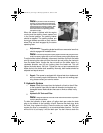
19
5. Jump Starting
Warning:
Failure to use this starting procedure can cause sparking, and the gases in the battery
to explode.
a. Attach the end of the red jumper cable to the Positive termi-
nal (+) of the charged battery.
b. Attach the other end of the red jumper cable to the Positive
terminal (+) of the low charge battery.
c. Attach the end of the black jumper cable to the Negative
terminal of the charged battery.
d. Attach the other end of the black jumper cable to the frame
of the unit with the low charge battery.
6.
Fuses:
There is one fuse located in the wiring between the ignition
and start switch and other electrical components. This is a stan-
dard plug-in type automotive fuse rated at 7.5 amp.
7.
Safety Switches:
There are five safety switches in the electrical
circuit which control the engine. They are (1) the blade clutch
switch, (2) the parking brake switch, (3) the left and (4) the right
steering lever switches and (5) the seat switch.They operate so
that in order to start the engine, the blade clutch switch must be off,
the parking brake must be engaged, and both steering levers must
be opened-out to the side in the neutral position. Once the engine
is started, the seat must be occupied and the parking brake must
be released before either of the steering levers is folded up to the
operating position or the engine’s electronic ignition will be shorted
out and the engine will stop. Also, the seat must be occupied
before the blade clutch switch can cause the blades to rotate.
8.
Safety Switch Operation Checks:
The following operational
checks should be made daily.
a.
Blade Clutch Switch:
Sit in the operator’s seat. With both
steering levers opened-out in the neutral position and the
parking brake engaged, turn the blade clutch switch “on”
and try to start the engine. The engine should not start. If it
does, the blade clutch switch must be replaced. If the
engine does not start, turn the blade clutch switch “off” and
start the engine. Now turn the blade clutch switch “on” and
the blades should rotate. If the blades do not turn, the blade
clutch switch must be replaced, the seat switch must be
replaced or the electric PTO clutch must be repaired.
b.
Parking Brake Switch:
Sit in the operator’s seat. With both
steering levers opened-out in the neutral position and the
blade clutch switch “off”, release the parking brake and try
to start the engine. The engine should not start. If it does,
01004029 Rev 99_2.fm Page 19 Monday, September 27, 1999 8:23 AM


















